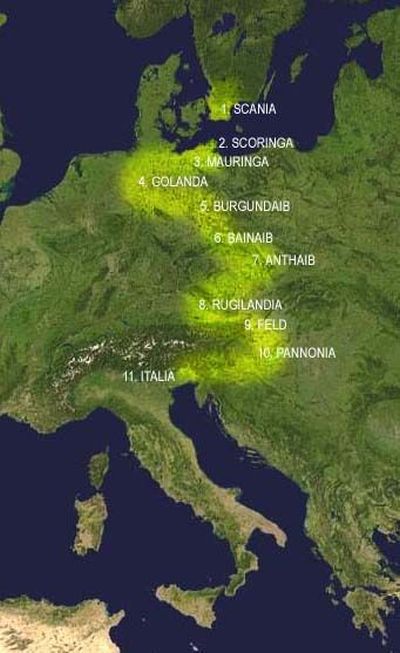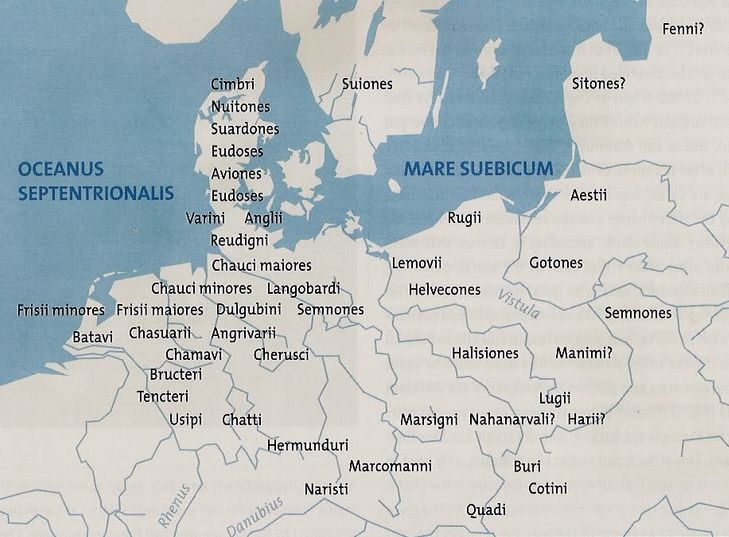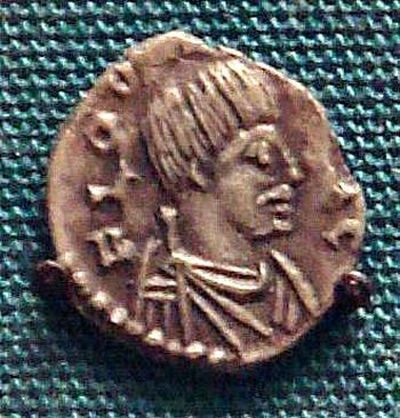
By the end of Procopius’ Book VI on the Gothic War in Italy, he loses interest in the war and writes instead about the Heruli, who was part of Belisarius’ army. He recounts among other things a decisive battle between Heruls and Langobards, which took place north of the Danube – possibly quite far north:

Reconstruction of the Langobards’ migrations – Langobards had given name to the region around Milan, Lombardy – Paul the Deacon mentions that the Lombards came from Scandia, but elsewhere he writes that they were not so numerous, because they came from only a small island, and this does not fit with Scandia. – Wikimedia Commons.
“And when the two armies came close to one another, it so happened that the sky above the Lombards was obscured by a sort of cloud, black and very thick, but above the Eruli it was exceedingly clear. And judging by this one would have supposed that the Eruli were entering the conflict to their own harm; for there can be no more forbidding portent than this for barbarians as they go into battle. However, the Eruli gave no heed even to this, but in absolute disregard of it, they advanced against their enemy with utter contempt, estimating the outcome of the war by mere superiority of numbers. But when the battle came to close quarters, many of the Eruli perished and Rodolphus himself also perished, and the rest fled at full speed, forgetting all their courage. And since their enemy followed them up, the most of them fell on the field of battle and only a few succeeded in saving themselves.”
“When the Eruli, being defeated by the Lombards in the above-mentioned battle, migrated from their ancestral homes, some of them, as has been told by me above, made their home in the country of Illyricum, but the rest were averse to crossing the Ister River, but settled at the very extremity of the world; at any rate, these men, led by many of the royal blood, traversed all the nations of the Sclaveni one after the other, and after next crossing a large tract of barren country, they came to the Varni, as they are called. After these, they passed by the nations of the Dani, without suffering violence at the hands of the barbarians there. Coming thence to the ocean, they took to the sea, and putting in at Thule, remained there on the island.”
Procopius was Belisarius’ secretary through three wars: against the Persians in Syria, against the Vandals in Africa and against the Goths in Italy. In all three wars, Heruls had been part of the Roman army. We must believe that Procopius had a very intimate relationship with them and that he had his information from the Heruli themselves. It is assumed that he published his reports on Emperor Justinian’s wars around 550 AD in Constantinople.
It is known from the Gothic chancellor Cassiodorus’ letters that the Goths in Italy tried to create an alliance with the Heruli, Thuringi and Varni against the Franks. Since he does not mention the Saxons, that we otherwise would expect, we must believe that Varni was an early name for the Saxons. We can imagine that the Saxons originally were called Varni and later got their name from their favorite weapon, the short single-edged sword, the sax; in the same way as the Langobards originally were called Vinil, but later was named after their favorite weapon, the long ax, langobard – bard as in the Danish name for halberd, hellebard.
 |
Reconstruction of the Germanic tribes following Tacitus. He did not create any map himself, but many writers have sought to place the tribes on a map following his description. As it can be seen Jutland and North West Germany are somewhat crowded at the expense of other areas. Tacitus mentions Varini after Anglii, and that is probably an error by Tacitus, who had all information on second hand. Varini must be the Saxons. From “The Spoils of Victory. The North in the Shadow of the Roman Empire”. Edited by L. Jorgensen, B. Storgaard and L.G. Thomsen. Nationalmuseet, Copenhagen.
In that case, the Herulian travel party had followed the Rhine or more likely the Elbe, crossed “a large distance of barren land”, perhaps Luneburger Heide, then traveled through the land of the Varni that most likely was Saxony, and from there through “the nations of the Dani” – notice that they are in plural – which must have been Jutland. Then they crossed the sea and landed in Thule, which is the Scandinavian Peninsula. As they traveled through Jutland through several of the Danes’ nations, we must believe that they traveled a good distance up in Jutland, before they sailed over to Halland and Scania.
The earliest mention of Varni is by Tacitus in “Germania”, in which he wrote: “Then follows in sequence and Reudignians, Aviones and Angles and Varinians and Eudoses and Suardones and Nuithones; all defended by rivers or forests.” This means that the Varinians were neighbors to the Angles, which fits very well with the idea that they were a kind early Saxons and lived south of the “the nations of the Dani”. Alternatively, it is suggested that Varni lived at the river Warnow and the city of Warnemünde, it would then lead to that the returning Heruls sailed from northern Germany to perhaps Blekinge and Scania, and that they not – as reported – “passed by the nations of the Dani” before they “took to the sea, and putting in at Thule”.

Coin with a portrait of Odovacar issued in Ravenna in 477 AD. He has a mustache following barbaric custom and maybe hair done up in a pillow. He was in all probability a Scirii, a Gothic-speaking people, but Consularia Italica calls him King of Heruli. Consularia Italica is a collection of documents published by Theodore Mommsen in 1892. Other sources claim he was of Gothic origin. But Heruls constituted a large part of his men, and he was Rex Italia, therefore he was actually King of Heruli, though he himself was not a Herul. Moreover, Scirii was a kind of Goths, and as Odovacar was a Scirii, one can also say that he was a Goth. Thus, all statements are true. Odovacar deposed the last Western Roman emperor, Romulus Augustulus, in 476 AD. Jordanes wrote about Odovacar: “Now that Augustus was appointed emperor in Ravenna by his father Orestes, it did not last long before Odoacer, King of Torcilingi (Thuringi), invaded Italy, as leader of Sciri, Heruli and allies of various races” – Photo Wikipedia.
In Procopius’ report on the Heruls, they assure him several times that they lived in their original homeland when they fought their destiny battle against the Longobards. They did not tell Procopius that they originated from Scandia or another island, as Jordanes says. However, the term “passed the nations of the Dani, without suffering violence at the hands of the barbarians there” reveals, however, a somewhat tense relationship with the Danes, which suggests that Jordanes was right. Perhaps it was too humiliating for them to admit to Procopius that they two times had been expelled.
Following Paul the Deacon, the Rugi who lived north of the Danube opposite the Roman province Noricum, were defeated by Odoacer, who reigned in Italy. This happened 487-88 AD. He says that the victor led the Rugians away in large quantities, and the Longobards moved into the now almost uninhabited Rugiland, which must have been northern Austria, some believe Moravia. Here they were attacked by the Heruli, who, however, lost the fateful battle that followed, so that they were forced to leave their own country, as they told Procopius. This battle must most likely have taken place around the year 500 AD – and according to Paul in an area immediately north of the Danube.
As previously explained, it is likely that some Heruls were expelled from Scandinavia by Dani maybe around 200-300 AD The returning Heruls thus came back through “the nations of the Dani” 200-300 years after they had been expelled the first time.
OFFICIAL AND REGISTEREDL CLAN CARRUTHERS CCIS SINCE 1983-CLAN OF OUR ANCESTORS
SCOTTISH CLAN – IRISH CLAN – NORSE CLAN
Preserving Our Past! Recording Our Present! Informing Our Future!
The Ancient and Honorable Carruthers Clan International Society LLC
CLANCARRUTHERS1@GMAIL.COM

CLAN CARRUTHERS INT SOCIETY CCIS HISTORIAN AND GENEALOGIST

You can find us on our main facebook pages at :
SILVER WINGS-https://www.facebook.com/CarruthersClanLLC/
GOLD WINGS – https://www.facebook.com/carrutherscarrothers.pat.9
CLAN CARRUTHERS FAMILY HISTORY – https://www.facebook.com/CarruthersClan
CLAN CARRUTHERS CCIS – https://www.facebook.com/groups/3878691252182714
CLAN CARRUTHERS INT SOCIETY- https://www.facebook.com/groups/394653845137709
CLAN CARRUTHERS – BORDER REIVERS – https://www.facebook.com/groups/434959914239094
Disclaimer Ancient and Honorable Carruthers Clan International Socie



